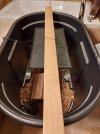KiraBeckham
Member
Hello,
I have recently welcomed a juvenile Redfoot into my home (approximately 2.5 to 3 years old we think).
I ordered the Arcadia pro t5 12% uvb 24" based on recommendations I saw here but am now doubting that purchase. I've since read that Redfoots, being a forest dwelling species do better with 6% uvb. It took me almost 2 weeks to get this light so I really don't want her waiting any longer to get that UVB but I also don't want the lighting to be too strong.
Bottom line, is the Arcadia pro t5 12% bulb a good choice for a Redfoot?
I've seen on here that 3 to 4 hours a day is enough for a Redfoot but my vet is advising 12 hours per day (or aligned with natural sun cycles). Thoughts?
Thanks so much, Kira
I have recently welcomed a juvenile Redfoot into my home (approximately 2.5 to 3 years old we think).
I ordered the Arcadia pro t5 12% uvb 24" based on recommendations I saw here but am now doubting that purchase. I've since read that Redfoots, being a forest dwelling species do better with 6% uvb. It took me almost 2 weeks to get this light so I really don't want her waiting any longer to get that UVB but I also don't want the lighting to be too strong.
Bottom line, is the Arcadia pro t5 12% bulb a good choice for a Redfoot?
I've seen on here that 3 to 4 hours a day is enough for a Redfoot but my vet is advising 12 hours per day (or aligned with natural sun cycles). Thoughts?
Thanks so much, Kira

